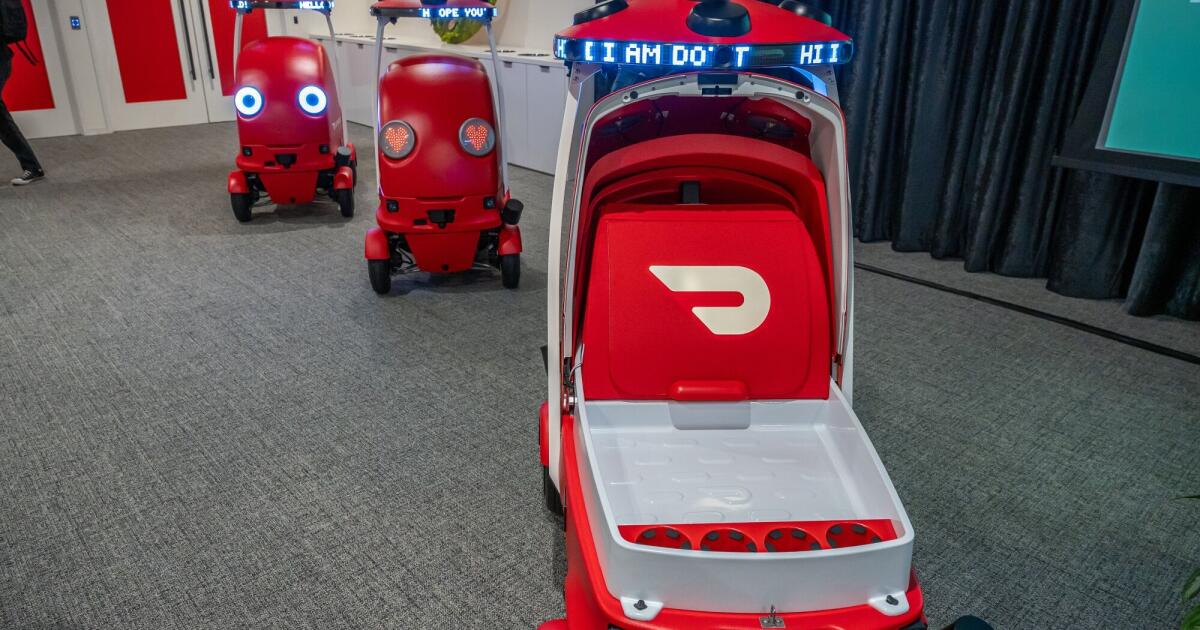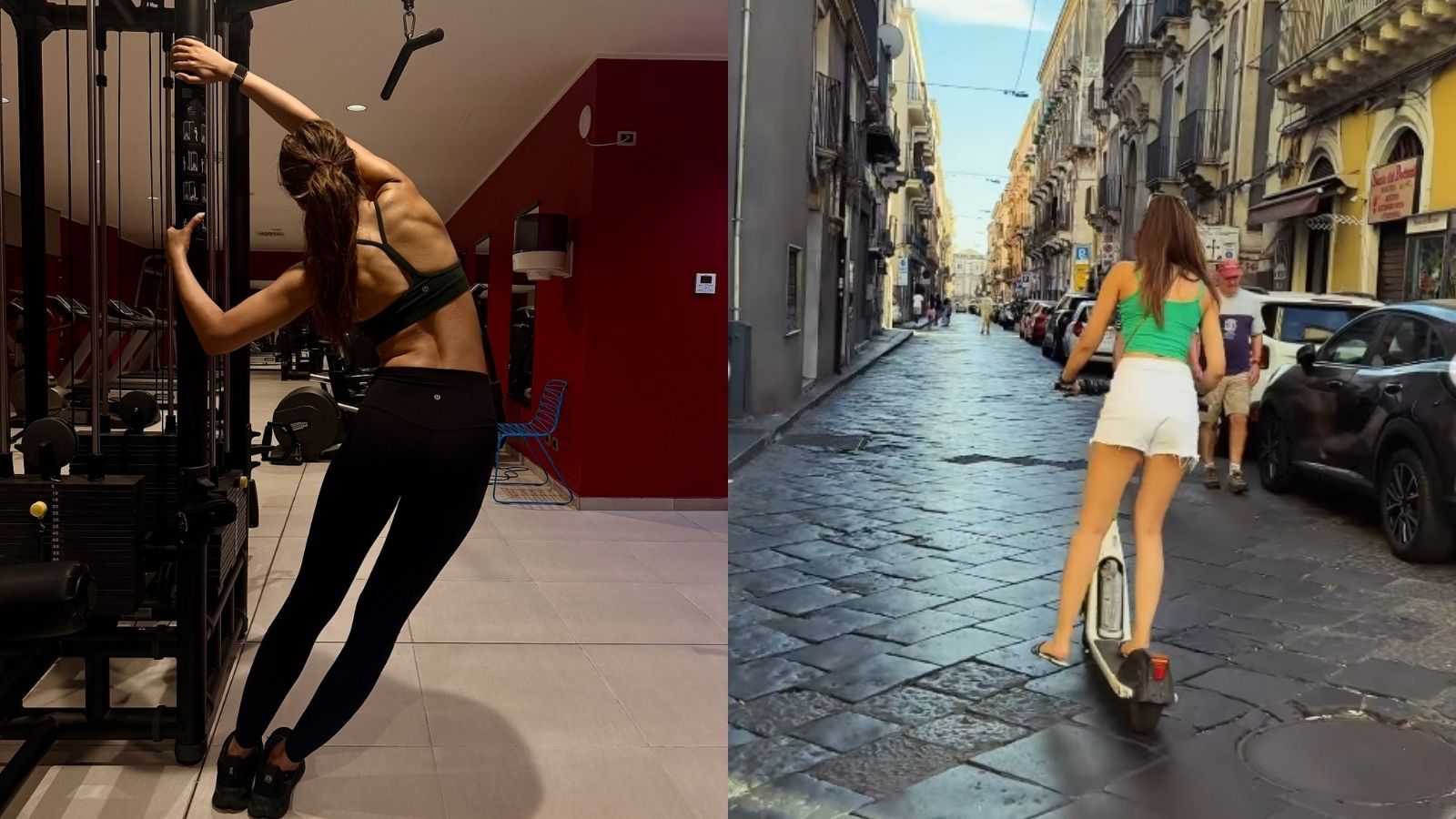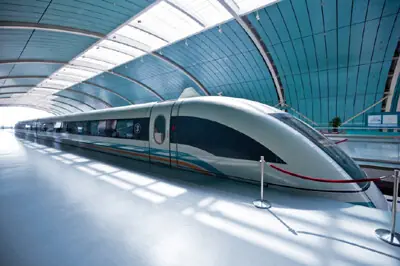
DoorDash Inc., the largest food-delivery app in the U.S., unveiled a delivery robot and a smart scale for restaurants, showcasing the company’s years-long effort to develop hardware.
DoorDash co-founder Stanley Tang showed off the four-wheeled autonomous robot, named Dot, at a gathering Monday for reporters at the company’s San Francisco headquarters. Dot stands 4 feet, 6 inches tall and uses a combination of external cameras, radars and lidar sensors on top of and below its storage compartment to perceive and navigate its surroundings. It’s one-tenth the size of a car and nimble enough to navigate through doorways and driveways, DoorDash said, but is big enough to fit six large pizza boxes and can carry up to 30 pounds of cargo.
Dot can travel as fast as 20 miles per hour on bike lanes, sidewalks and roads, according to the company, which has been running an early access program for some restaurants in Tempe and Mesa, Ariz. That’s faster than the maximum speeds of sidewalk robots programmed by its partner, Coco Robotics, and Uber Eats’ partner Serve Robotics Inc. DoorDash’s electric robot uses a swappable battery that can hold as much as six hours a charge.
While Coco and Serve’s robots are more akin to a boxy drink cooler on wheels, the Dot’s main compartment is round — similar to a large cheese wheel — and was inspired by the D-shaped logo of the company. It opens up from the front like a baby stroller.
DoorDash is still in the process of discussing where it will manufacture and source components for the robot, said Ashu Rege, vice president of autonomy, in an interview with Bloomberg Television on Tuesday. The company declined to comment on the size of its current fleet, but said it plans to expand commercially to additional markets in the future.
On Tuesday, DoorDash also debuted a smart scale to help restaurants weigh orders before they are handed to couriers to reduce missing-item claims.
The announcements are the first public showcase of DoorDash’s robotics and automation efforts, which have been led by Tang since 2018 under the DoorDash Labs unit. Having filed the first patents for a robot and laid out its vision in 2021, the company is now making the commercial case for its autonomous ambitions at a time when its main competitor Uber Technologies Inc. has also been proactively laying out its driverless-vehicle strategy.
DoorDash still primarily uses human couriers to fulfill customer orders for meals, groceries and retail products. It has also partnered with Coco Robotics and Alphabet Inc.’s drone venture Wing to explore autonomous delivery methods, but only at a small scale in a handful of markets. Dot will be another way for the company to make deliveries, especially for bigger orders and longer distances in the suburbs, Tang said, adding that DoorDash is working on machine-learning systems to determine the most optimal delivery method based on price, cost and location.
The company said the robot will “see” using eight external cameras that provide 360-degree coverage, one interior camera to ensure delivery quality, four “inexpensive” radar units and three high-resolution lidar sensors, which are currently included for situational awareness. The lidar sensors will be replaced with “inexpensive automotive-grade lidar” to lower the cost of expanding production, DoorDash said.
Two circular light displays in the front also act as cosmetic “eyeballs” of the robot and “look” left and right depending on where it is navigating. The round design and interactivity help add a friendly personality to the robot and make it more acceptable within the community it is serving, according Ashu Rege, vice president of autonomy.
The company said it’s looking to fill dozens of roles in hardware, software, artificial intelligence and autonomy engineering and operations at DoorDash Labs to further roll out Dot and other technologies. The company has been quietly expanding the team over the past year to lay the groundwork for its autonomy efforts, including by hiring dozens of former staff from General Motors Co.’s Cruise unit when it first shuttered the self-driving business.
Those ex-Cruise employees now hold positions in product design, policy, business development and partnerships, remote support of the robots, and recruiting, according to a Bloomberg News analysis of employee profiles on LinkedIn.
On Tuesday, DoorDash also launched new app updates including a “Going Out” feature in the U.S. and Australia that lets users make restaurant reservations and its subscription members to earn rewards when dining in person. The updates follow its $1.2-billion acquisition of restaurant tech company SevenRooms earlier this year and rivals a similar feature launched by Uber Eats in partnership with Booking Holdings Inc.’s OpenTable.



